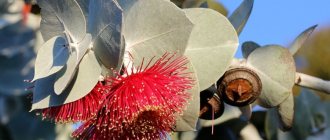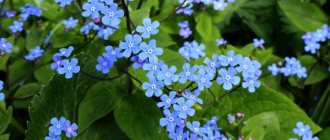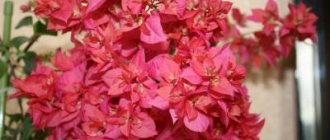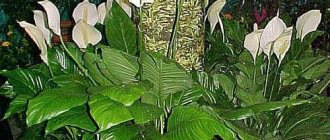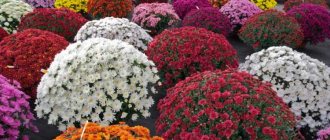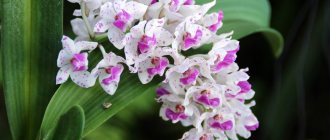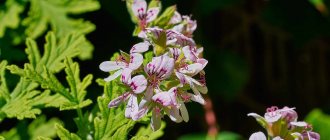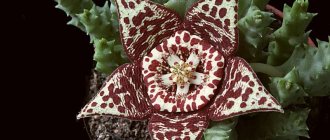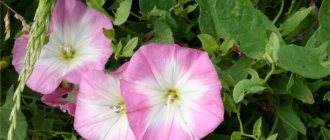From this article you will learn how to grow and maintain a blooming indoor adenium flower, photo. You can get acquainted with the variety of the plant, its types and characteristics. You will see adenium, photos and care at home, which is quite simple, but requires its own conditions, like any other indoor plant. Before buying this flower, familiarize yourself with its features and find out what harm it can cause. Take a closer look at the adenium photo and choose your favorite flower that will decorate your home.
Types of plants, appearance
Adenium flower is a plant that resembles a small tree in appearance with a thick trunk and a compaction at the base called caudex. The stem of the adenium flower curls profusely, and is decorated with numerous flowers with a blunt or pointed end.
Adenium Boehmianum
Poisonous variety. The leaves bloom only for 3 months, and they are located on the branches in a spiral.
Adenium Arabian
The leaves of this subspecies have a wide surface. Its shape is squat, with a wide base; from a distance, the differences between the branches and the trunk are not at all noticeable. The color can be red and pink, and the skin ranges from purple to brown.
Adenium Crispum
Its base resembles the shape of a turnip, which is what makes it unique. Fine roots grow from the lower part of the trunk, which is underground, while thicker roots grow at the base of the above-ground trunk. Crispum's stems are not very thick and reach 30 cm in height.
Adenium Multiflorum
It is white in color with a bright pink fringe, and is grown as a poison for hunting fish or mammals.
Adenium Oliefolium
This type of plant is the shortest of all. The flowers have a pink tint and are about 4 cm in diameter. Under natural conditions, the flower eye is white or yellow, but different varieties may have darker shades. Oliefolium blooms only in summer.
Adenium Socotra
The trunk has the shape of a column, branched. The branches are arranged in a bush-like manner and reach a height of 3 meters or more. It is quite simple to distinguish Socotrans adenium from other species: clear horizontal stripes are visible on its caudex and trunk.
Adenium Swazicum
The leaf color is light green. The flowers are solid colors, usually pink, but breeders have developed clones that are bright red, pink-purple or white. The plant needs rest, and the duration of its growth and flowering depends on the conditions in which it is grown.
Adenium Obese
Adenium obesum flowers are often pink or red in color with a white outer “neck”. It is also used as an arrowhead poison for hunting in Southern African countries.
Adenium somali
Somali adenium is very easy to grow at home; it is quite unpretentious. It is enough just to observe the rest period (November/December). The leaves have a bright green color, an elongated shape, and reach 6 - 11 cm in length and 1.7 - 2.5 cm in width. In winter, its leaves fall off.
Adenia Mini
Adenia mini is a dwarf tree with a branched crown. Flowering of mini-adeniums occurs in the second year of cultivation. The flowers are similar to roses and can reach 7–8 cm in diameter.
Dangerous neighbors
As for energy, the advice to get rid of stunted and diseased plants in a timely manner is psychologically justified. Few people will feel better at the sight of a dying plant. If for some reason it was not possible to keep it healthy and strong, then the best solution would be to give the plant to someone who will properly put it in order.
Poinsettia, akalifa, codium, philodendron, calla, and aglaonema have similar properties. Their juice irritates the skin and mucous membranes of the mouth and eyes, and if it enters the intestines, it causes nausea, diarrhea and vomiting. Hyacinth, clivia, and hippeastrum are especially poisonous in this regard.
Other representatives of this Kutrov family have a similar effect: Pachypodium, Dipladenia, Periwinkle, Adenium. Why can't they be kept at home? These indoor plants contain poison that weakens the heart activity of humans and animals.
Very intensely toxic compounds are released during plant care (watering, spraying, propagation).
If you decide to grow these indoor plants in your apartment, remember first aid measures.
Knowing which house plants cannot be kept at home, you can anticipate many unpleasant situations related to the health of family members.
How to grow, care and pests and diseases
Adeniums are easy to care for at home, but there are a few tips for maintaining them. The optimal temperature for the plant is +25 – 35 degrees. It is advisable to keep actively growing adenium in conditions with high air humidity. The optimal lighting for this plant is direct sunlight. The plant needs to be watered in the morning, approximately every day.
There are several pests that affect adenium with the following names: scale insects, nematodes, aphids, spider mites, mealybugs.
Adenium can have only two diseases: bacterial burn or caudex rotting. Bacterial burn occurs due to increased air humidity; the leaves begin to turn yellow. To heal a plant, you need to stop spraying it with water, remove damaged leaves, treat everything with an antiseptic and improve the soil. Caudex rot may not be noticeable for a long time, this is its danger. It happens due to excessive watering and excess moisture in the soil. It is especially noticeable in autumn or winter. When disease occurs, the leaves turn yellow and fall off, and the stem becomes very soft. If the roots are rotting, you need to cut off the stem that is higher than the rotting stem.
Reproduction methods
Growing adenium from seeds
When stored for a long time, adenium seed loses its germination capacity; therefore, only fresh seeds should be used for sowing. Their sowing is carried out in the last winter or first spring weeks.
The container is filled with a substrate consisting of charcoal, sand and vermiculite. The seeds need pre-sowing preparation; for this they are placed in a solution of potassium manganese for 30 minutes, and then they are kept for several hours in a lukewarm Zircon solution. The seeds must be distributed over the surface of the substrate, and then they are covered with a thin layer of soil mixture. The crops are placed in a warm place (from 33 to 35 degrees), after a week seedlings will appear. If the crops are located in a cooler place, the seedlings may appear later or this may not happen at all. When the plants appear, they will need to be illuminated with fluorescent lamps, they will also need to be provided with regular ventilation, and the air temperature in the room should be at least 18 degrees.
After the first two true leaf plates have formed on the flower, they begin to gradually care for it like an adult specimen. And when 2 more leaf plates are formed, the seedlings should be picked into individual containers.
Cuttings
Propagation by apical cuttings is a rather complicated process, as they can easily rot. Cuttings are carried out in summer or spring. The cuttings need to be divided into parts, the length of which should be about 12–15 centimeters, then they need to be dried by treating the sections with charcoal. In order for the cuttings to take root, you need to use perlite, a mixture of sand and charcoal or small expanded clay. It is necessary to pour sand or small charcoal around the root collar, thanks to this the base of the stem will not rot. Cuttings need bright sunlight, and the air temperature should never be below 25 degrees. The soil should not be over-moistened. If everything is done correctly, the cuttings will take root after 4 or 5 weeks.
ADENIUM. The most effective way to root cuttings of varietal adeniums on the “Flower Fairy” channel.
How to propagate by layering
In May and June, such a succulent can be propagated by air layering. Take a very sharp knife and use it to make a circular cut on the shoot (the stem should be 20 mm in diameter). After the incision site has dried, it should be treated with a solution of a product that stimulates root growth. Wrap this place with sphagnum moss, which should be wrapped on top with opaque cellophane. Don't forget to regularly wet the moss. After about 4 weeks, roots should appear, then the cuttings are separated from the mother plant and planted in a container filled with substrate intended for an adult bush.
Reproduction by grafting
To graft such a crop, you can use another adenium or Oleander. Make cuts on the scion and rootstock using a very sharp knife, then they are combined with each other, and then the plants are firmly held together (you can use a special spray). Make sure that the air temperature in the room is not less than 30 degrees, the air humidity should be high, and you will also need bright lighting. The new bush must be protected from direct rays of the sun, and the sprouts that appear on the rootstock must be cut off immediately.
Adenium. Grafting for dummies
Sign: is it possible to keep a cypress tree at home?
A beautiful exotic plant will decorate any home or office. But what do the signs say about this?
There are those who call it the tree of death and believe that cypress has no place in the house. This flower absorbs positive energy.
Women who want to build a happy family need to get rid of cypress. This flower is a muzhegon.
Signs prohibit placing cypress in the bedroom - it will negatively affect mental abilities.
Of course, you don’t have to believe in omens, but if you want to start landscaping your apartment, you need to know which flowers you can’t keep at home. Whether you like it or not, you have to take the signs into account. And not because our ancestors decided so, but because the negativity that the signs warn about is easily confirmed from a scientific point of view.
Sign: orchid in the house
Whether orchids are useful flowers for the home or not, superstitious opinions regarding this flower differ greatly. Some believe that an orchid can absorb vital energy and have a bad influence on a man. This flower can turn a man into a soft and pampered boy. Therefore, you cannot place this flower in the bedroom.
Others consider the orchid to be an exclusively female flower, which “gives” a girl beauty and femininity, improves health, and increases self-esteem. It is believed that it does not absorb positive energy in the house, but rather improves it and takes all the negativity upon itself.
There is an opinion that an orchid can protect a house from bad guests, causing them a feeling of discomfort.
Why can't you keep violets at home?
Violets are a fairly popular indoor plant. But some housewives are still scared off by the signs associated with it.
People often call him muzhegon. It is believed that a woman will not know the happiness of family life if violets grow in her house.
According to another sign, superstitions also do not favor this flower. Violets are believed to absorb positive energy in the home.
But there are also positive signs about this plant. On the contrary, many consider violets to be a symbol of prosperity and strong relationships.
Why can't you keep cacti at home?
If you want your husband to love you, don’t keep a cactus at home. Our ancestors also believed that this flower destroys the family and leads to the husband having a mistress. It also negatively affects the sex life of a married couple.
According to legend, the cactus with its thorns drives away suitors from unmarried girls. You can’t give it to a lonely girl or woman. According to superstitions, such a prickly gift promises loneliness for life.
Superstitious people also see a bad sign in the blooming of a cactus. It is believed that the flower foreshadows an imminent quarrel in the family. And according to some signs, the blooming of a prickly flower has more serious consequences - perhaps it is a sign of the imminent death or serious illness of one of the family members.
But this sign also has another, positive meaning - it is worth waiting for the birth of a child or an imminent wedding.
Adenium transplant
Replanting is a fairly common process, but an inexperienced gardener is faced with the question of how to replant correctly and not harm the flower in any way, because it is, after all, stressful. The sequence of steps for transplantation is simple:
- Prepare a new pot and soil. Fill the pot halfway; do not forget to place a two-centimeter layer of drainage on the bottom.
- Wear gloves: adenium is poisonous and it is dangerous to come into contact with open skin, especially if you need to trim the roots.
- Carefully remove the plant from the pot.
- Clean the roots, you can rinse under running water.
- Inspect the root system: is there any rot? Also inspect the lower parts of the leaves, which are usually not visible to the eye: this is where pests, such as aphids, often hide.
- If you notice rotten or dried roots, it is recommended to remove them. If you notice pests, remove them, rinse the plant under running water, and immediately after replanting, treat with an appropriate preparation for your type of pest.
- If everything is in order, then you can replant. Place the plant in the center of the pot and fill in the remaining soil. There is no need to crush: the roots need air. Also, you should not decorate the soil, put something on top of it (this is sometimes done when they want to form adenium in the bonsai style) - this interferes with its “breathing”.
- Watering after replanting should be done no earlier than two days later, because the roots, being under stress from replanting, can easily rot.
When and how often to replant
A young plant (up to about two years old) is replanted no more than twice a year: in winter and summer. The reason for this is that the flower grows very quickly, and its pot quickly becomes small.
After two years, they are replanted once a year, preferably in early spring, so that the plant does not waste growth time adapting after replanting.
Priming
Neutral acidity, sterile, loose, because adenium is a plant with aerial roots, and the roots need to provide an influx of oxygen. If you are going to make the soil yourself, then add part of the peat and part of the river sand (it will act as a loosening agent for the soil).
A drainage layer is also necessary - expanded clay, crushed brick - because adenium is afraid of overflow, and drainage protects against it.
By the way, the question “how to increase the adenium caudex” (“grow your butt,” as they also say) will be answered by the earth. It is necessary to use poor soil without nutrients, and provide nutrients with the help of fertilizers, so that the adenium gains them “for future use”, accordingly, increasing the caudex.
Another way: place the nutritious parts of the soil (for example, humus) along the edges, closer to the sides of the pot, so that the roots are forced to reach towards them. But keep in mind that such machinations usually lead to “fatification,” that is, the plant will actively invest in the development of the root system, but will not bloom.
Pot
A regular plastic pot will do. Ceramics are undesirable because they get very hot in the summer and, on the contrary, cool down in the winter, which causes rotting of the root system.
If you are growing desert flowers for the first time, then it is advisable to purchase a pot with transparent walls: adenium is afraid of overflowing, it needs to be watered only when the earthen ball is completely dry, and if it is in a pot with transparent walls, it is much easier to monitor the drying of the soil.
Description
The shape of the flowers is funnel-shaped. Depending on the Adenium variety, the inflorescences may consist of a different number of flowers, their color: red, white, cold or warm shades of pink. Forms with double flowers are known.
Sometimes a combination of two colors is observed: for example, petals painted white or pink become crimson closer to the edge. Often there is a yellow center in white or pink flowers, a white center in red ones.
There are very beautiful varieties with a pattern of stripes radiating from the center.
The leaves are entire, elongated, elliptical or pointed in shape, less often - somewhat widened towards the outer edge (drop-shaped). They can be located in bunches closer to the ends of the branches or alternately along the entire length of the branch.
Caudex formation
The most decorative part of the plant is the powerful trunk (caudex). It is not easy to form it; this must be done from a very early age of the flower and not skip a single intermediate stage.
Adeniums photo
Crown and root trimming
The thickness of the trunk and the branching of the roots will directly depend on the splendor of the tree’s crown. In the first 3-4 months, pinching of the upper buds is done. This can be done manually, without improvised means. The buds or buds of young leaves are removed, and in their place two new buds will later form. The crown will begin to branch.
Roots also form in the first six months of a flower’s life. The first thing to do is remove the central root to stimulate the growth of the lateral ones. If you delay this, the root will become woody and will become more difficult to remove. After 2 years, this procedure is dangerous for the plant.
When pruning the crown and forming roots, the caudex itself will thicken and grow in width. During the first 6-10 months, pinching is done, later - full pruning. Often the central trunk is cut off to stimulate the growth of side shoots. At the same time, the caudex stops growing upward, but begins to thicken and take on bizarre shapes.
Splicing multiple trunks
Allows you to obtain the most intricate forms of caudex. Immediately after germination from the seeds, the sprouts are planted together in one container and the stems are tied. After 2 months, the bandage is removed, and incisions are made in the places where the seedlings touch. Connect the trunks together and bandage them again with film.
After a month, the bandage is removed again. During this time, the plants manage to grow together firmly in close contact. At the same time, the caudex takes on an unusual shape, which cannot be achieved by simply trimming the crown and roots. The most interesting thing. If you grow together adeniums of different varieties. The flowering will be unusual - multi-colored, with double and smooth flowers on one tree.
Extreme root pruning
Experienced gardeners form the caudex using extreme pruning. First, the central root and all the others going down are removed from the young plant. A circle of plastic equal to the diameter of the young trunk is placed on the ground. Adenium is placed on a circle, the lateral roots are spread along the edges of the circle and sprinkled with soil.
The adenium itself is secured with supports - sticks or knitting needles - so that it does not fall. It's labor-intensive and risky. It is important to monitor the soil moisture - it should be slightly damp all the time, but not wet. The roots will begin to grow into the soil and thicken, and the caudex will also grow in breadth. This will form an unusual form of adenium called “octopus”.
What flowers can you keep at home?
Not everything is so bad for lovers of indoor plants - there are also useful flowers. But not every housewife knows what flowers can be kept at home.
These are indoor plants with beneficial properties that will help create a positive climate in your home. In addition, housewives not only keep most of them in the house for beauty, but also for use as a cure for many ailments.
Temperature
The life of a plant is quite clearly divided into periods: wintering, or dormancy, and active growth. Adenium requires a gradual transition from one mode to another.
The optimal temperature in summer, in the warm season, is about 20˚C. It is necessary to take into account the climate of a particular area: temperature and humidity.
The maximum temperature in summer is no more than 30˚C.
In winter, during the rest period, the room temperature should be moderate: about 12˚–15˚С.
Adult plants usually calmly tolerate nighttime temperature drops to +5˚–0˚С, provided that during the day the air warms up to +10˚С and above. However, it must be remembered that with such a decrease in temperature, the risk of root rot .
Sign: palm trees at home
Plants that look like a palm tree will decorate the interior of any apartment. These include calathea, rapis, howea belmora, patching and others.
Superstitious opinions about whether it is possible to grow a palm tree in the house are divided. Some believe that these are harmful indoor plants and not only cannot be kept in the house, but they cannot even be brought into your home (they can cause trouble). Although superstitions found a loophole in this sign - the sign does not say anything that a palm tree cannot be brought into the house.
If you were given a palm tree, plant it in your yard.
Others believe that it is impossible to attract love, luck, joy and wealth into the house without such a plant and it must be kept at home.
What indoor palm trees are recommended by superstitions? It could be calathea - it will help a girl meet her love as soon as possible, chamedorea - it promotes career growth.
Sign: ivy in the house
The attitude of superstitions towards ivy is ambiguous. Opinions differ even about the same sign. Some believe that ivy, like all climbing plants, repels men, while others “help” a young girl get married quickly.
According to one sign, ivy in the house will absorb all the good things, and according to another, on the contrary, it will eliminate all adversity and help improve relationships.
Previously, women looked after ivy if they wanted to protect themselves from problems in their relationship with their husband. A young girl was recommended to wear a sprig of this flower on her chest to remain beautiful and desirable.
Superstitions consider this flower to be the culprit of many financial problems.
